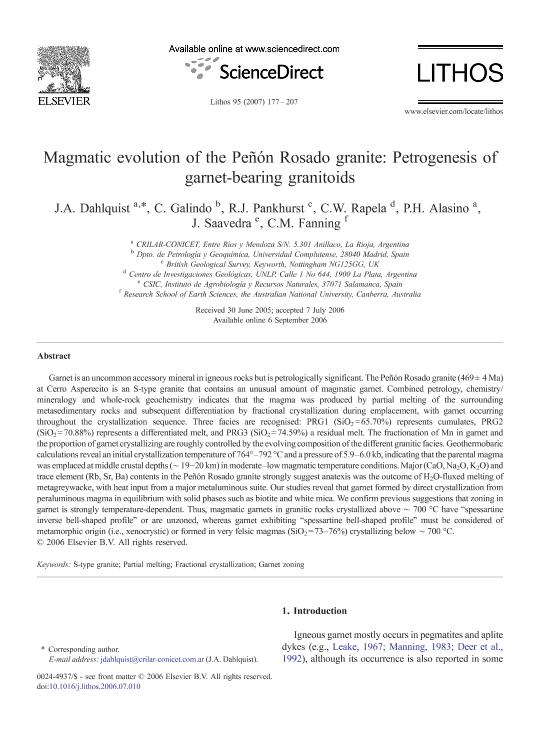Artículo
Magmatic evolution of the Peñón Rosado granite: Petrogenesis of garnet-bearing granitoids
Dahlquist, Juan Andrés ; Galindo, C.; Pankhurst, R. J.; Rapela, Carlos Washington
; Galindo, C.; Pankhurst, R. J.; Rapela, Carlos Washington ; Alasino, Pablo Horacio
; Alasino, Pablo Horacio ; Saavedra, J.; Fanning, C. M.
; Saavedra, J.; Fanning, C. M.
 ; Galindo, C.; Pankhurst, R. J.; Rapela, Carlos Washington
; Galindo, C.; Pankhurst, R. J.; Rapela, Carlos Washington ; Alasino, Pablo Horacio
; Alasino, Pablo Horacio ; Saavedra, J.; Fanning, C. M.
; Saavedra, J.; Fanning, C. M.
Fecha de publicación:
05/2007
Editorial:
Elsevier Science
Revista:
Lithos
ISSN:
0024-4937
Idioma:
Inglés
Tipo de recurso:
Artículo publicado
Clasificación temática:
Resumen
Garnet is an uncommon accessory mineral in igneous rocks but is petrologically significant. The Peñón Rosado granite (469 ± 4 Ma) at Cerro Asperecito is an S-type granite that contains an unusual amount of magmatic garnet. Combined petrology, chemistry/mineralogy and whole-rock geochemistry indicates that the magma was produced by partial melting of the surrounding metasedimentary rocks and subsequent differentiation by fractional crystallization during emplacement, with garnet occurring throughout the crystallization sequence. Three facies are recognised: PRG1 (SiO 2 = 65.70%) represents cumulates, PRG2 (SiO 2 = 70.88%) represents a differentiated melt, and PRG3 (SiO 2 = 74.59%) a residual melt. The fractionation of Mn in garnet and the proportion of garnet crystallizing are roughly controlled by the evolving composition of the different granitic facies. Geothermobaric calculations reveal an initial crystallization temperature of 764°-792 °C and a pressure of 5.9-6.0 kb, indicating that the parental magma was emplaced at middle crustal depths (∼ 19-20 km) in moderate-low magmatic temperature conditions. Major (CaO, Na 2 O, K 2 O) and trace element (Rb, Sr, Ba) contents in the Peñón Rosado granite strongly suggest anatexis was the outcome of H 2 O-fluxed melting of metagreywacke, with heat input from a major metaluminous suite. Our studies reveal that garnet formed by direct crystallization from peraluminous magma in equilibrium with solid phases such as biotite and white mica. We confirm previous suggestions that zoning in garnet is strongly temperature-dependent. Thus, magmatic garnets in granitic rocks crystallized above ∼ 700 °C have "spessartine inverse bell-shaped profile" or are unzoned, whereas garnet exhibiting "spessartine bell-shaped profile" must be considered of metamorphic origin (i.e., xenocrystic) or formed in very felsic magmas (SiO 2 = 73-76%) crystallizing below ∼ 700 °C.
Palabras clave:
Fractional Crystallization
,
Garnet Zoning
,
Partial Melting
,
S-Type Granite
Archivos asociados
Licencia
Identificadores
Colecciones
Articulos(CCT - LA PLATA)
Articulos de CTRO.CIENTIFICO TECNOL.CONICET - LA PLATA
Articulos de CTRO.CIENTIFICO TECNOL.CONICET - LA PLATA
Articulos(CICTERRA)
Articulos de CENTRO DE INVEST.EN CS.DE LA TIERRA
Articulos de CENTRO DE INVEST.EN CS.DE LA TIERRA
Articulos(CRILAR)
Articulos de CENTRO REGIONAL DE INV. CIENTIFICAS Y TRANSFERENCIA TECNOLOGICA DE ANILLACO
Articulos de CENTRO REGIONAL DE INV. CIENTIFICAS Y TRANSFERENCIA TECNOLOGICA DE ANILLACO
Citación
Dahlquist, Juan Andrés; Galindo, C.; Pankhurst, R. J.; Rapela, Carlos Washington; Alasino, Pablo Horacio; et al.; Magmatic evolution of the Peñón Rosado granite: Petrogenesis of garnet-bearing granitoids; Elsevier Science; Lithos; 95; 3-4; 5-2007; 177-207
Compartir
Altmétricas



